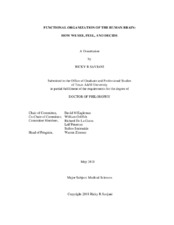Functional Organization of the Human Brain: How We See, Feel, and Decide.
Abstract
The human brain is responsible for constructing how we perceive, think, and act in the world around us. The organization of these functions is intricately distributed throughout the brain. Here, I discuss how functional magnetic resonance imaging (fMRI) was employed to understand three broad questions: how do we see, feel, and decide? First, high-resolution fMRI was used to measure the polar angle representation of saccadic eye movements in the superior colliculus. We found that eye movements along the superior-inferior visual field are mapped across the medial-lateral anatomy of a subcortical midbrain structure, the superior colliculus (SC). This result is consistent with the topography in monkey SC. Second, we measured the empathic responses of the brain as people watched a hand get painfully stabbed with a needle. We found that if the hand was labeled as belonging to the same religion as the observer, the empathic neural response was heightened, creating a strong ingroup bias that could not be readily manipulated. Third, we measured brain activity in individuals as they made free decisions (i.e., choosing randomly which of two buttons to press) and found the activity within fronto-thalamic networks to be significantly decreased compared to being instructed (forced) to press a particular button. I also summarize findings from several other projects ranging from addiction therapies to decoding visual imagination to how corporations are represented as people. Together, these approaches illustrate how functional neuroimaging can be used to understand the organization of the human brain.
Citation
Savjani, Ricky R (2018). Functional Organization of the Human Brain: How We See, Feel, and Decide.. Doctoral dissertation, Texas A & M University. Available electronically from https : / /hdl .handle .net /1969 .1 /173284.


